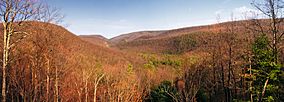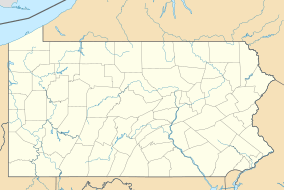Bald Eagle State Forest facts for kids
Quick facts for kids Bald Eagle State Forest |
|
|---|---|

Bald Eagle State Forest vista from Pine Swamp Road in Centre County
|
|
| Location | Pennsylvania, U.S. |
| Area | 194,602 acres (787.53 km2) |
| Elevation | 1,788 ft (545 m) |
| Governing body | Pennsylvania Department of Conservation and Natural Resources |
| Website | https://www.dcnr.pa.gov/StateForests/FindAForest/BaldEagle/Pages/default.aspx |
Bald Eagle State Forest is a huge natural area in Pennsylvania. It's managed by the Pennsylvania Bureau of Forestry. The main office for the forest is in Laurelton, which is in Union County. This amazing forest stretches across five different counties: Centre, Clinton, Mifflin, Snyder, and Union Counties.
Bald Eagle State Forest is so big that it touches other state forests. It shares a border with Rothrock State Forest to the west and Tiadaghton State Forest to the north. Inside Bald Eagle State Forest, you can find five Pennsylvania State Parks. These are Poe Valley, Poe Paddy, R. B. Winter, Reeds Gap, and Sand Bridge. There are also two places that used to be state parks: Snyder-Middleswarth Natural Area and Hairy Johns Picnic Area.
Contents
History of the Forest
Bald Eagle State Forest was created because Pennsylvania's forests were disappearing fast. This happened in the mid-to-late 1800s. Back then, companies cut down almost all the trees to get wood and iron. They would clear-cut huge areas, leaving behind only dry branches and tree stumps.
This made the land very dry. Sparks from passing steam locomotives often started huge wildfires. These fires stopped new trees from growing back. People who cared about nature, like Dr. Joseph Rothrock, worried that the forests would never grow again. They knew something had to change.
These conservationists asked the state government to buy land from the logging and iron companies. The companies were happy to sell because they had already cut down most of the valuable trees.
Changes started in 1895. Dr. Rothrock became the first commissioner of the Pennsylvania Department of Forests and Waters. This department later became today's Pennsylvania Department of Conservation and Natural Resources. In 1897, the state government passed a law. This law allowed them to buy "empty lands for forest reservations." This was the start of the state forest system we have today!
Fun Things to Do
Bald Eagle State Forest is a great place for outdoor adventures. You can enjoy many different activities here.
- Hiking
- Mountain Biking
- Picnicking
- Fishing
- Hunting
- Camping
- Horseback Riding
- Cross Country Skiing
- ATV Riding
- Snowmobiling
Horse Riding Trails
If you love horses, you're in luck! You can ride horses on most of the forest's shared trails. These trails are over 300 miles long! You can also ride on state forest roads. However, horses are not allowed on the Mid State Trail (MST). They are also not allowed on special hiking trails (marked with yellow blazes) or in Natural Areas.
The trails range from easy to very difficult. Some might be too hard because of rough ground. The forest has a special network of trails called the Central Mountains Shared Use Trail. This network has 120 miles of trails perfect for hiking, biking, and horses. Some campsites in the forest are even set up for camping with horses.
Events in the Forest
Each year, Bald Eagle State Forest hosts special events. One popular event is the Wilderness 101. This is a challenging mountain bike race that covers 101-mile (163 km) of forest trails.
Nearby State Forests
Bald Eagle State Forest shares its borders with several other state forests:
- Tiadaghton State Forest (to the north)
- Weiser State Forest (to the east)
- Tuscarora State Forest (to the south)
- Rothrock State Forest (to the southwest)
- Sproul State Forest (to the northwest)
Special Natural Places
Bald Eagle State Forest has unique natural areas that are protected.
Hiking Trails
- Pennsylvania Mid State Trail
Natural Areas
Natural Areas are special places where nature is protected and left mostly untouched.
- Joyce Kilmer Natural Area; 77 acres (31 ha)
- The Hook Natural Area; 5,119 acres (2,072 ha)
- Mt. Logan Natural Area; 512 acres (207 ha)
- Rosecrans Bog Natural Area; 152 acres (62 ha)
- Snyder Middleswarth Natural Area; 500 acres (202 ha)
- Tall Timbers Natural Area; 660 acres (267 ha)
Wild Areas
Wild Areas are even more untouched than Natural Areas. They are kept as wild as possible.
- White Mountain Wild Area; 3,581 acres (1,449 ha)
Images for kids




